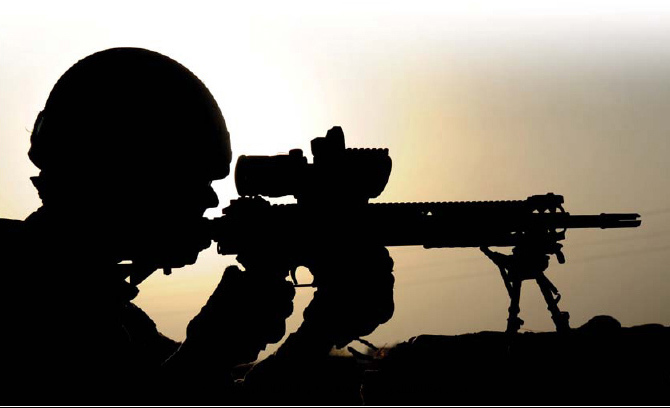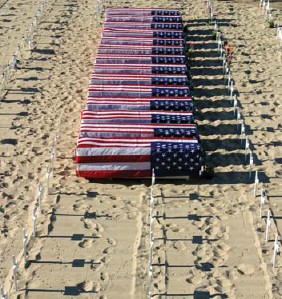Shape
Our eyes – or brains – are designed to pick up on familiar shapes. The shape of a black rifle or a body lying on the floor will catch our eye much more if they are all the same colour and we can see all the shape which makes up the object. The two main ways to break up a shape are to colour different areas differently, like a camouflage suit, or to hide part of the shape from sight – keeping half of you behind a bush for instance.
REMEMBER:
Rank insigina: Don’t show rank insignia – ‘Stripes’ and ‘Pips’ – on active service. Any sniper worth his salt will hit the leader first followed by the radio operator followed by the gunner. On ops the team will know who is who and you don’t want the opposition to know. Also, when giving orders don’t point or wave when there may be a sniper about as it soon becomes obvious who the boss is.
A human face catches the eye too so when you are watching someone it is often a good idea to drape a veil across your face. This is a sort of string-mesh cloth in a square a couple of feet across. From the inside this hardly obstructs your vision at all but from the outside is blends in with cover extremely well.
Shine
There are very few bits of shiny kit still in everyday use. Brass buckles are a thing of the past. But polished boots, metal equipment and worst of all your sweaty face can still shine alarmingly in random light when it is dull or dark. Wear brown boots if possible, camouflage your rifle and make sure you apply cam-cream to your face. Even if you’re really dark skinned you still want to use black or green camouflage cream to dull your skin. We all get sweaty and shine by reflection at night.

If you want to live forever, don’t make a silhouette. (Barry Lloyd © UK Crown Copyright, 2009, MOD)
With regards to the use of light be very, very careful when smoking, lighting cigarettes and reading maps at night. It’s a good idea to watch someone doing all of the above in darkness to see how good a target you make. When you strike a light or shine a light on a map you light up all the faces looking at it and make a perfect aiming point for a sniper. Like so many things, this is where carelessness gets you killed.
Muzzle flash: Take notice the next time you do a night-firing exercise, or go on the range at night to see how your muzzle flash lights up the whole area around you. In a firefight at night you should move after each burst – wriggle backwards, roll sideways, then forwards to shoot again. Or at least duck into your hole for a few moments if you cannot move. If you don’t do this all the opposition might be shooting at you the next time you fire after a lull. The first to fire after a break in shooting very often gets everyone else firing at them so don’t let them have you in their sights and be waiting for you.
Shadow
There are two things to know about shadow: one to avoid and one to take advantage of.
Avoid: When you are in open ground and the sun is bright you will make a shadow, obviously. Given you, your hut or your vehicle are cammed up and keeping still you might think you are fairly invisible. Not so. When the sun is above you your shadow is small but as the sun goes down your shadow can become much bigger than yourself and, worst of all, it is black on the ground. Particularly when viewed from the air or from a hill looking down, the shadow is often the first thing you see of a person, vehicle or building if they are the same colour as their surroundings.
REMEMBER:
Remember to consciously aim lower at night as the instinct is to shoot high if you don’t have proper night sights. It is amazing how people shoot high at night when firing at each other’s muzzle flashes. If you can aim down you will hit ten times as many of the enemy.
What can you do? With your body make sure there is higher cover than yourself next to you. When you camouflage vehicles and buildings make sure you stretch the netting out in the direction of the shadow so the enemy see the net and not the shadow.
Take advantage: When you are viewing or shooting from a window, dark hollow or shaded area under a tree make sure you sit well back from the sunlit area. This will make you far less visible, the enemy will be less able to judge where you were after your muzzle flash and less able to hit you if you are in a building because you will have more protection from the window surround.

You can hardly see the crosses but look how visible the shadows of the crosses are. This illustrates my point. (i-Stock)
Sudden movement
I think men evolved to see moving prey when hunting. True or not, it is a fact that anything which moves catches your eye. Even when well cammed a walking man catches your eye far more than a static individual. When you have to move in view of the enemy then either move very, very slowly, for instance if you are coming up to the aim, or move quickly and get it over with.
Hard targeting: When you have to walk along a street, and you don’t know if there is a sniper watching, you need to ‘Hard Target’. What this means is you avoid giving a steadily moving target for the sniper to set his lead on. You will recall that if you can get a moving target to move directly towards or away from you then it might as well be stationery for the ease of hitting it. If a moving target is going left to right steadily then you just have to aim a certain distance ahead of it.
If a target is hard-targeting, that is a couple of steps forward, then a step sideways, then a step back, then forward again all at random it is extremely difficult to hit from any distance. We were first taught this for patrolling the streets of Northern Ireland and it is both hard work and mildly embarrassing to do but you can make yourself a very difficult target – if you can stand looking a fool. Put in the effort to hard target and you will not get hit – the sniper will hit the lazy man who cannot be bothered.
TOP TIP!
Flares
If a flare lights you up hit the ground and freeze. Wriggling around for a better position will get you noticed.
Silhouette
Look through cover – such as a bush, rather than around it. This way you don’t attract attention by breaking up the skyline with a familiar and moving silhouette. If you can’t look through cover then look around the side of cover rather than over the top. Looking over the top of something is the best way to get spotted.
When on a cross-country march try to avoid walking along ridges. Anyone lower than yourself can see you as plain as a pike staff as a black silhouette against the sky. Deadly.
Smell
I think Western men use their sense of smell a lot less than women. Have you ever seen a man smell his food like women often do? There is probably something there from our hunting origins where men would be killing meat and women would be testing fruit and berries by smell. Although having a poor sense of smell can be a big help when living in cramped conditions with a lot of smelly marines.
The opposition, however, depending on where you are in the world, may have a very well developed sense of smell and use this to find you in heavy cover. Particularly in the jungle or heavy bush where you will often be fighting almost at touching distance and a man smelling of tobacco or after-shave or garlic etc may give a warning to your enemy and either spoil the ambush or get you all killed.